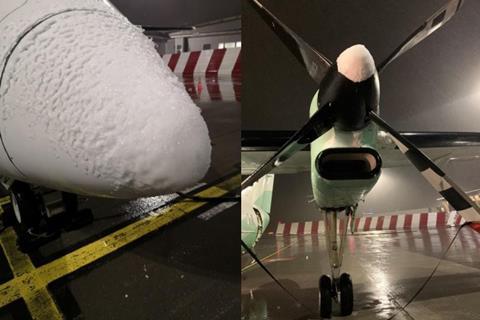Norwegian investigators have disclosed that a Wideroe De Havilland Dash 8-300 momentarily lost power in both engines when they flamed out on approach to Bergen, after the aircraft was inadvertently routed through a region of severe icing.
The turboprop had departed Kristiansund on 20 January 2020, and its crew was given a direct clearance to an approach waypoint near Bergen.
While the Dash 8 had not been de-iced – the crew had believed this unnecessary – its de-icing systems were active as it climbed.
Moderate, but not severe, icing had been forecast. Ice started to form on the aircraft around 14,000ft but the crew expected to pass through the icing layer and climb above cloud, as on the three preceding flights that day.
Norwegian investigation authority SHK says the icing, however, intensified as the aircraft gained altitude and remained considerable when the Dash 8 levelled at 22,000ft. The sole cabin crew member found the situation “dramatic”, it adds, because the aircraft was vibrating abnormally, and ice shed from the propellers was striking the fuselage.
The crew attempted to remove the ice using the de-icing systems and different propeller speeds. In an effort to find warmer air they descended to 16,000ft and changed course, flying west towards the coast – even though the deviation from the direct route would burn additional fuel.

SHK says the icing persisted, building up on the wings, propeller spinners and flap fairing, and the pilots informed the inquiry that, at one point, the windows were nearly completely iced over.
The crew adjusted course to reduce the flying distance to Bergen and descended to 12,000ft, observing that the icing increasingly broke away and its intensity reduced.
As the aircraft began its approach to Bergen’s runway 17, the icing continued to dislodge but, while passing 6,700ft, the left-hand Pratt & Whitney Canada PW123 engine flamed out as inlet icing detached.
The engine subsequently restarted automatically and returned to normal power after 25s.
But 51s later the right-hand engine also flamed out at 5,200ft, and the crew declared an emergency. It took two attempts to relight and, just as the right-hand engine’s power started to increase, that of the left-hand engine began to fall again.
Thirteen seconds elapsed between the loss of power on the left engine and the restoration of normal power on the right.
“The aircraft was therefore completely without engine power for a few seconds,” says the inquiry. The left engine regained power after a further 18s as the aircraft descended through 4,500ft.
“Had the engine failure happened a few minutes later, with the aircraft in full landing configuration with landing-gear and flaps, and at lower altitude, the outcome of the incident could have been far more serious,” says SHK.

But the rest of the approach and landing took place without further incident and the crew cancelled the emergency call. Examination of the Dash 8 (LN-WFO) after it parked showed substantial quantities of ice still on the airframe.
SHK says the engines had either flamed out as a result of ice entering the combustion chamber as slush and water, or stalled as a result of disrupted airflow. Inspection of the engines revealed chipped or bent compressor blades in both.
None of the 14 passengers and three crew members was injured. The inquiry specifically credits the pilots’ communication and professionalism, noting the consistent focus on the icing issue and the good authority gradient between captain and first officer.
Norway’s meteorological institute remarked that the severe icing encountered during the flight, the result of supercooled large droplets, was present at an unusually high altitude. The upper limit would normally be set at minus 20°C – because freezing water rarely occurs in large quantities at such low temperatures – and this would have corresponded to an altitude of 18,000ft.
Weather balloon data found that the temperature at 22,000ft – the cruising level of the aircraft – was nearly minus 30°C. The institute believes the relevant air mass might have been given additional lift from mountain waves, as well as lift from encountering physical terrain.



















